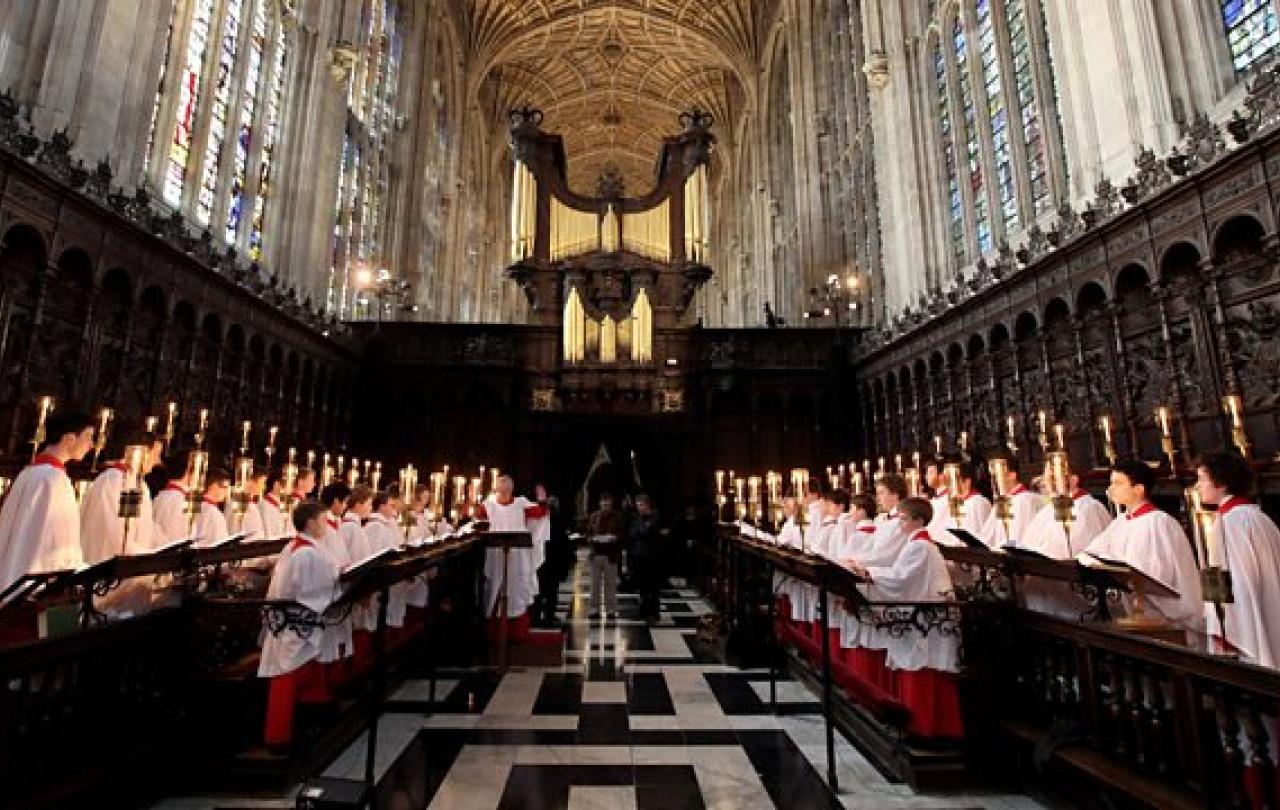
I have decided that I will make it an annual ritual to grumpily defend a Christmas tradition that I love. Last year it was the traditional Nativity Play. This year it is the traditional carol service. For over a hundred years, at King’s College Chapel at least, the traditional Festival of Nine Lessons and Carols has borne witness to the very best of Anglican liturgy. The service combines candlelight, communal and choir carol singing, and lessons from Holy Scripture in a beautifully evocative manner. I adore the service, and it is very much a highlight of my Advent contemplation.
I am thrilled to say that carol services seem to be as popular as ever! I can hardly name a church that won’t be putting one on, either solo or uniting with other parishes. This warms my heart…and yet a shard of ice remains. A small, but very important gripe: editing. I notice that many services don’t follow the traditional pattern of nine lessons. Some have six. Some five. Some only a few, focusing as much as possible on the carol singing. I have a few clergy friends who enjoy giving me a gentle ribbing when I tell them my plans: “Oh you’re not doing ALL NINE are you!? Oh dear! It’ll be so long!”
Brevity can be a virtue, and the Church hasn’t always cultivated it. I understand people have busy lives, and that very few of us want to be out late on a cold, wintry evening. I know that mince pies and mulled wine are as close to an irresistible temptation as there could be. I know that 30 to 45 minutes of hymn singing with a bit of Bible seems so lovely and compact. I understand all of this.
However, I want to argue in favour of keeping all nine lessons: the length is the point!
We end with a meditation on primordial concepts that cannot be truly comprehended by any mortal, and can only be put to paper in poetry.
Some of the lessons are long (I’m looking at you Genesis!), and some a wonderfully pithy. It starts at the very beginning of the Bible and spends a good deal of time – nearly half of the readings – meditating on Genesis and Isaiah before we even begin to get to the baby Jesus, and the manger, and the shepherds, and the wise men. We seem to take ages not actually reading about the Story of Christmas…and this is VITAL!
The traditional carol service concludes with the Prologue of John, that masterful exposition of the theology of the Incarnation, the perfect encapsulation of what a Christian believes is the truth, and the light, and the meaning of Jesus being born in a stable in Bethlehem. The service concludes with mention of the Word, of pre-existence, of Creation, of light defeating darkness, of salvation wrought through spirit and not flesh. We end with a meditation on primordial concepts that cannot be truly comprehended by any mortal, and can only be put to paper in poetry…and yet this is the true meaning of Christmas, and the true meaning of the Scriptures. Everything from Genesis 1.1 has been leading up to this, and everything written in Scripture only makes sense in light of these remarkable verses by John (or so Christians believe).
When defending the traditional Nativity, I wrote about narrative and story and how they are fundamental to understanding our place in the world and the very meaning of our lives. The same can be said about the full nine lessons. Starting at the Fall of Mankind in the Garden of Eden, stopping to ponder the mercy and promise of God to Abraham and Isaac, being confronted with the wonderful Prophecies of Isaiah (the promise of peace and joy in the Kingdom of God), and then charting the story of the miraculous Birth of Christ, we see the underlying narrative thread of all Scripture: God loves His creation, God makes a promise to His creation, God keeps His promise and brings salvation and reconciliation to His creation. The Christmas story is wonderful and joyous, but it is an act in a larger drama, and we cannot truly understand it (or how it relates to the Prologue of John) if we don’t allow ourselves to encounter the whole story.
Perhaps I’m putting too much emphasis and expectation on a single service in the year. Carol Services are celebratory, and anything that makes them accessible to as many people as possible is not something I want to malign…but…I pray that the full sweep of Scripture, the full and precious golden thread of the narrative of Scripture, is not lost. It is the meaning of Christmas, and it is the meaning of life, and it fills me with joy when it is celebrated with fellowship, singing, and worship.
Anyway, grump over. I’m going to eat a mince pie.
Join with us - Behind the Seen
Seen & Unseen is free for everyone and is made possible through the generosity of our amazing community of supporters.
If you’re enjoying Seen & Unseen, would you consider making a gift towards our work?
Alongside other benefits (book discounts etc.), you’ll receive an extra fortnightly email from me sharing what I’m reading and my reflections on the ideas that are shaping our times.
Graham Tomlin
Editor-in-Chief





